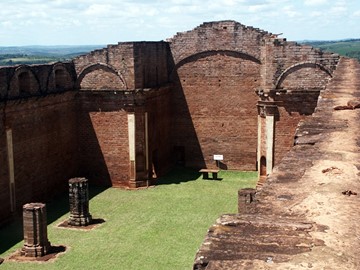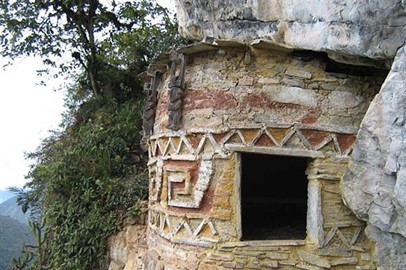region :: latin america and the caribbean
Portobelo and San Lorenzo
Portobelo and San Lorenzo, a UNESCO World Heritage site in Panama, are historic colonial fortifications built by the Spanish in the 16th and 17th centuries along the Caribbean coast. These well-preserved sites, including the forts of San Lorenzo and various structures in Portobelo, were strategically designed to protect transatlantic trade routes and defend against pirate attacks. The area showcases a blend of military architecture and natural beauty, with stone walls, cannons, and scenic coastal views. Rec... Read More
Darien
Darién National Park, a UNESCO World Heritage site in Panama, spans over 575,000 hectares of pristine wilderness along the border with Colombia. This biodiverse region features lush rainforests, rugged mountains, and extensive wetlands, serving as a critical habitat for endangered species like the jaguar, harpy eagle, and Central American tapir. Its unique location bridges North and South America, making it a vital ecological corridor. The park also holds cultural significance, encompassing indigenous terri... Read More
Panamá Viejo
Panamá Viejo, a UNESCO World Heritage site in Panama, is the oldest European settlement on the Pacific coast of the Americas, founded in 1519 by Spanish conquistador Pedro Arias Dávila. This historic city, originally a thriving colonial hub, features the ruins of its early stone buildings, including a cathedral, convents, and homes, which reflect its role as a key trading center until its destruction by pirates in 1671. Today, the well-preserved archaeological site offers a glimpse into Panama’s colonial pa... Read More
Coiba
Coiba National Park, a UNESCO World Heritage site in Panama, is a biodiverse marine and terrestrial reserve encompassing Coiba Island and 38 smaller islets in the Pacific Ocean. Spanning over 430,000 hectares, it protects a range of ecosystems, including tropical rainforests, coral reefs, and mangroves, which support unique species like the Coiba howler monkey and rare marine life. Established as a national park in 1991 and recognized by UNESCO in 2005, it serves as a critical sanctuary for conservation and... Read More
Jesuit Missions of Paraná and Tavarangue
The Jesuit Missions of La Santísima Trinidad de Paraná and Jesús de Tavarangue, located in Paraguay, are a UNESCO World Heritage site recognized in 1993 for their historical and cultural significance. These 17th- and 18th-century missions, founded by Jesuit missionaries, blended European Baroque architecture with indigenous Guaraní craftsmanship, creating a unique cultural fusion. The well-preserved ruins, including grand churches and communal spaces, reflect the Jesuits’ efforts to integrate and educate th... Read More
Cuzco
Cuzco, a UNESCO World Heritage site in Peru, is a historic city nestled in the Andes Mountains at an elevation of about 3,400 meters (11,150 feet). Once the capital of the Inca Empire, it showcases a remarkable blend of pre-Columbian and colonial architecture, including the iconic Qorikancha temple and the grand Plaza de Armas. Its well-preserved ruins, vibrant culture, and role as a gateway to Machu Picchu make it a global treasure. Today, Cuzco thrives as a center of indigenous heritage and tourism.
Machu Picchu
Machu Picchu, a World Heritage site in Peru, is a remarkably preserved 15th-century Inca city nestled high in the Andes Mountains. Built with precise stonework, it features terraces, plazas, and residential structures that showcase advanced engineering and architectural skill. Discovered in 1911 by Hiram Bingham, it offers insights into Inca civilization and attracts visitors worldwide for its historical significance and stunning scenery.
Chavin
Chavín de Huántar, a UNESCO World Heritage site in Peru, is an ancient archaeological site dating back to around 1200 BCE. Located in the Andean highlands, it served as a major ceremonial and cultural center for the Chavín civilization, known for its distinctive art and architecture. The site features a complex of stone structures, including the U-shaped Old Temple and the larger New Temple, adorned with intricate carvings of felines, birds, and anthropomorphic figures. Its significance lies in its role as ... Read More
Huascarán
Huascarán National Park, a UNESCO World Heritage site in Peru, spans 340,000 hectares of the Cordillera Blanca mountain range, featuring the country's highest peak, Huascarán, at 6,768 meters. Established in 1975, it protects diverse ecosystems, including montane forests, glacial lakes, and unique high-altitude Puya raimondii plants. The park is home to rare wildlife like the Andean condor, spectacled bear, and vicuña. Its stunning landscapes and biodiversity make it a critical conservation area and a draw ... Read More
Chan Chan
Chan Chan, located in Peru, is a UNESCO World Heritage site recognized as the largest pre-Columbian adobe city in the Americas. Built by the Chimú civilization around 850 AD, it served as their capital until the Inca conquest in the late 15th century. The sprawling archaeological site features intricate mud-brick structures, including palaces, temples, and plazas, showcasing advanced urban planning and engineering. Today, it stands as a testament to the Chimú's cultural and architectural achievements, despi... Read More
Lima
The Historic Centre of Lima, a UNESCO World Heritage site in Peru, showcases a remarkable blend of colonial architecture and urban planning from the 16th century. Founded by Spanish conquistador Francisco Pizarro, it served as the political and administrative heart of Spain’s South American empire, featuring landmarks like the grand Plaza Mayor, the ornate Archbishop’s Palace, and the Basilica Cathedral. The site preserves a rich history of European influence, with its grid layout and baroque-style building... Read More
Río Abiseo
Río Abiseo National Park, a UNESCO World Heritage site in Peru, is renowned for its exceptional biodiversity and archaeological significance. This protected region harbors a rich variety of flora and fauna, including rare species like the yellow-tailed woolly monkey. The park also contains over 30 pre-Columbian archaeological sites, most notably the Gran Pajatén ruins, offering valuable insights into ancient Andean civilizations. Its remote location and pristine ecosystems make it a critical conservation ar... Read More
Nasca and Palpa
The Lines and Geoglyphs of Nasca and Palpa, a UNESCO World Heritage site in Peru, are a remarkable collection of ancient earthworks created by the Nasca culture between 500 BCE and 500 CE. These massive designs, etched into the desert floor, include straight lines, geometric shapes, and detailed figures of animals and plants, visible primarily from the air. Scholars believe they served ceremonial or astronomical purposes, reflecting the Nasca people's sophisticated understanding of their environment and cos... Read More
Arequipa
The Historic Centre of Arequipa, a UNESCO World Heritage site in Peru, is renowned for its well-preserved colonial architecture, blending European and indigenous influences. Constructed primarily from white volcanic sillar stone, the city's buildings showcase ornate facades, arches, and courtyards, reflecting its rich history as a key Spanish settlement in the 16th century. Notable landmarks include the grand Basilica Cathedral and the Santa Catalina Monastery, a sprawling complex of colorful cloisters and ... Read More
Caral Supe
Caral-Supe, a World Heritage site in Peru, is recognized as one of the oldest civilizations in the Americas, dating back to around 2600 BCE. This archaeological site features monumental architecture, including pyramids, plazas, and residential complexes, showcasing advanced urban planning and social organization. Its significance lies in its well-preserved state, offering insights into early Andean culture, agriculture, and trade practices. Caral-Supe stands as a testament to the ingenuity of its ancient in... Read More
Manú
Manú National Park, a UNESCO World Heritage site in Peru, is a biodiversity hotspot spanning Andean highlands, cloud forests, and lowland rainforests. It harbors an exceptional array of wildlife, including jaguars, giant otters, and over 1,000 bird species, alongside rare flora like giant bromeliads. Recognized for its pristine ecosystems and cultural significance, it also protects indigenous communities, some living in voluntary isolation. This ecological and cultural treasure is a globally significant con... Read More
Brimstone Hill Fortress
Brimstone Hill Fortress, a UNESCO World Heritage site, is a well-preserved 17th-century military fortification showcasing British colonial architecture and engineering. Constructed by African slaves, it features robust stone walls, barracks, and cannons strategically positioned to defend against European rivals. The fortress served as a key stronghold during conflicts in the Caribbean, reflecting its historical significance as a symbol of colonial power and resistance. Today, it stands as a testament to the... Read More
Pitons Management Area
This World Heritage site in Saint Lucia encompasses a stunning volcanic landscape featuring two towering spires—Gros Piton and Petit Piton—rising dramatically from the sea, surrounded by lush tropical forests and vibrant coral reefs. Spanning 2,909 hectares, it includes a geothermal field with sulphur springs and fumaroles, showcasing the region’s volcanic history and natural beauty. Recognized by UNESCO in 2004, the area supports diverse ecosystems with endemic species and offers breathtaking views, making... Read More
Paramaribo
Paramaribo, the capital of Suriname, is a UNESCO World Heritage site renowned for its well-preserved colonial architecture, reflecting a unique blend of Dutch, British, and French influences from the 17th and 18th centuries. The city’s historic inner center features wooden buildings, including the iconic Saint Peter and Paul Cathedral, showcasing intricate craftsmanship. Its cultural significance stems from its role as a trading hub in the Caribbean, with a diverse heritage shaped by indigenous, African, an... Read More
Central Suriname Nature Reserve
The Central Suriname Nature Reserve, a UNESCO World Heritage Site in Suriname, is a pristine tropical rainforest ecosystem formed in 1998 by merging three existing reserves with support from Conservation International and the government. Recognized in 2000 for its outstanding biodiversity, it safeguards a variety of habitats including montane and lowland forests, granite domes, and the upper watershed of the Coppename River. The reserve hosts over 5,000 plant species, 400 bird species like the Guiana Cock-o... Read More
Colonia del Sacramento
Colonia del Sacramento, a UNESCO World Heritage site in Uruguay, is a charming historic town founded by the Portuguese in 1680. Known for its well-preserved colonial architecture, cobblestone streets, and picturesque waterfront along the Río de la Plata, it offers a glimpse into the region’s past as a contested settlement between Spanish and Portuguese powers. Key landmarks include the iconic lighthouse, the Basilica of the Holy Sacrament, and remnants of ancient fortifications, making it a cultural treasur... Read More
Fray Bentos Industrial Landscape
The Fray Bentos Industrial Landscape, a UNESCO World Heritage site in Uruguay, is a historic industrial complex established in 1859 along the Uruguay River. It showcases the complete meat production process—from sourcing and processing to packing and dispatching—featuring the Liebig Extract of Meat Company’s facilities (starting in 1865) and the Anglo Meat Packing Plant (from 1924), which supplied meat extract, corned beef, and frozen meat to global markets. This site highlights the technological and cultur... Read More
Coro
Coro and its Port, located in northwestern Venezuela, is a UNESCO World Heritage site recognized for its unique earthen architecture and historical significance. Founded in 1527, it showcases a remarkable blend of local traditions with Spanish Mudéjar and Dutch architectural techniques, evident in its well-preserved colonial buildings and original street layout. As one of the first colonial towns in Latin America, it served as Venezuela’s initial capital and the continent’s first bishopric. Since 2005, it h... Read More
Canaima
Canaima National Park, a UNESCO World Heritage site in Venezuela, is renowned for its stunning natural beauty, featuring dramatic tepuis (table-top mountains), lush rainforests, and cascading waterfalls, including the world-famous Angel Falls, the highest uninterrupted waterfall on Earth. The park is a biodiversity hotspot, home to unique flora and fauna, such as the carnivorous pitcher plants and the elusive jaguar. It also holds cultural significance, with indigenous Pemon communities living harmoniously ... Read More
Ciudad Universitaria de Caracas
Ciudad Universitaria de Caracas, a UNESCO World Heritage site in Venezuela, is a remarkable example of modernist architecture designed by Carlos Raúl Villanueva. Completed between the 1940s and 1960s, it serves as the main campus of the Central University of Venezuela, blending functional buildings with open plazas, lush gardens, and striking artworks. Its innovative design and cultural significance earned it global recognition as a masterpiece of urban planning and architectural creativity.
























